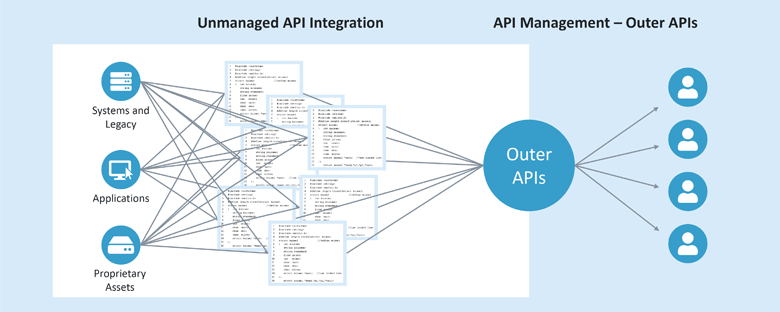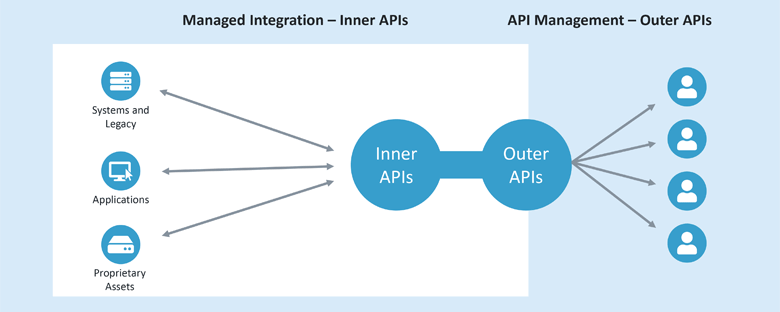
Many companies start their API management projects with high expectations. However, taking an API first approach to design often leads to a dilemma. How should this user-friendly “outer” API – the “API product” – actually be integrated with the backend infrastructure? Is there an API management solution which also lets you integrate the API to the backend infrastructure? If not, then there are high costs involved in hiring a backend developer – if you can find one who isn’t already busy. Another alternative companies use is to employ standardised software for API integration. This lets you accelerate the pace of your API management projects and secure the success of the business initiatives they support.
There’s no successful API management without API integration
APIs have established themselves as the preferred approach for providing real-time access to data or system functions (provisioning APIs). However those designing APIs don’t always consider how best to integrate them into the backend infrastructure. Instead, approaches such as API first mean that an API is designed from a user perspective – to be as user-friendly and intuitive as possible. This is a good thing, because it raises the adoption rate of these APIs.
However, many companies quickly discover that their specialist API management solutions, with their focus on management tasks, don’t have that many options for backend integration, or for orchestrating data provision and accessing the functions available backend.
Often, purely API management solutions only offer tools for API mediation, brokering between “inner APIs” and “outer APIs” (read-only solutions for external API users). However, how do you create “inner APIs”, that is, how do you make backend infrastructure API-enabled?
The fact is that most systems and applications do not come with mature, flexible API interfaces. If they do include an API interface or two, questions quickly arise as to whether such an interface is enough for the use case and whether it can orchestrate more complex data and function calls to support an outer API. What happens if your API management solution is being operated from a vendor or public cloud, but the backend infrastructure is on-premises or in a multi-cloud scenario? How do we sustainably solve the problem of how to make “inner APIs” available or to directly implement “outer APIs”?
If you’re asking these questions, you’ve realised something. An API management solution needs an effective solution for API integration, too.
Backend developers aren’t an effective alternative to a standardised API integration solution
Many IT organizations elect to use back-end developers to ensure that the systems and applications in the back-end infrastructure are “API-ready”. Sometimes “inner-APIs” are programmed in such a way that they can be accessed for multiple use cases. However, sometimes “outer-APIs” have been coded without considering the backend at all. The result is that integrating APIs tends to become the most troublesome and time-intensive part of an API project.
In our experience, more than one-third of the time and effort needed for an API project tends to be spent on backend API integration – assuming you can actually get enough specialists in the first place.
 Figure 1: Unmanaged API Integration
Figure 1: Unmanaged API IntegrationMedium-term, there is an even more serious issue. APIs have been coded with no common integration logic system and using several different interface technologies. This disparate information is scattered all over the place, which makes it extremely difficult to perform support or maintenance. It’s also near impossible to alter or reuse coded API integrations – never mind searching for and resolving errors when the systems are in use.
Make a success of your API initiative by using a holistic API solution
Using a professional API integration solution relieves you of these challenges. Why not consider the SEEBURGER Business Integration Suite (BIS), which completely removes the programming work and all the associated disadvantages on your side? SEEBURGER BIS provides everything you need for efficient API integration and maintenance in one central place, whether for inner or outer APIs. Many connections to backend systems and applications are as easy as a simple configuration, using the API solution’s standard tools, adaptors and connectors. This makes an API remarkably easy to set up and manage, or in more complex cases, orchestrated over all the backend systems they require.
 Figure 2: Managed Integration – Inner APIs
Figure 2: Managed Integration – Inner APIsEssentially, your entire backend infrastructure becomes API-enabled. This means that it is easy to centrally maintain, reuse and operate it. You also save on the time, effort and manpower which customised backend development would require, while still ensuring the success of your API initiative.
The SEEBURGER API solution can also complement a third-party API management solution. Your API designers, testers, developers and your integration team can work on an API project together, using their preferred tools for the API lifecycle stage in question.
What are the advantages of the SEEBURGER BIS API solution?
- Reduces the time and effort needed for API integration:
The standardised adapters and connectors it contains makes integrating a huge variety of backend systems and applications as easy as a simple configuration. - A safe, sustainable investment, with everything you need in one place:
Its centralised configuration, maintenance and management creates a more sustainable API front to your backend landscape than scattered coding. - Higher flexibility, customisability and security:
Simply decouple outer APIs and the backend infrastructure when appropriate. - It’s easy to transfer or customise APIs:
Backend interfaces can be mapped directly to an API and then customised or extended. - Higher performance:
SEEBURGER BIS can manage the very high traffic you could expect if your API initiatives are successful. - Reuse existing interfaces and APIs:
It lets you use pre-configured connections to backend systems and applications and recombine existing APIs to integrate further APIs.
The SEEBURGER BIS API platform is the perfect solution or addition to unlock the full potential of your API management infrastructure and significantly accelerate your API projects. With comprehensive API integration capabilities, even sophisticated backend integration becomes a simple interface configuration task for your integration team. The hybrid integration platform makes it easy to orchestrate, manage, and monitor your entire API data and information flow.
Source: https://blog.seeburger.com/how-api-management-projects-go-awry-if-you-forget-about-api-integration/
 expertise
expertise
